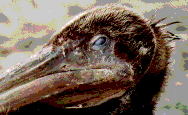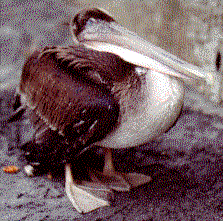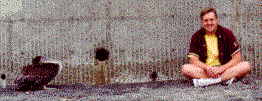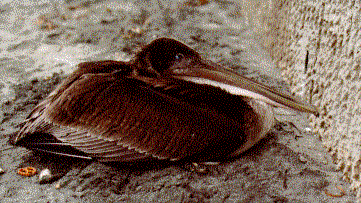Mr. Pelican is Dead by Russell D. Hoffman
Mr. Pelican is Dead

 By Russell D. Hoffman. Copyright (c) 1996 by Russell D. Hoffman.
By Russell D. Hoffman. Copyright (c) 1996 by Russell D. Hoffman.
I've always called them Mr. Pelican, because they look so
stately. They fly so gracefully, and they dive so boldly and
assuredly, and nearly always, it seems, come up gulping back a fish.
We caught a pelican last fall. I didn't catch it, my friend caught
it, by accident. He was casting from a boat in the middle of the
Oceanside, California harbor, and immediately the bait hit the water, a
pelican was on top of it, trying to eat it. He had sort of hopped
over from about 30 feet away when my friend cast the line. We didn't realize they
would do that. We were using big slightly defrosted fish for bait,
and I guess it makes sense that they'd see that as free food.
My friend tried to snatch the line away before the pelican could
swallow it, but he hooked the bird's enormous pouch, so
we reeled him in and unhooked him. I wanted to cut the line so we
could pass the hook through without more damage, but my friend
thought that time was paramount and it would be faster to just unhook
it. I was holding the bird's wings so it wouldn't flap around so
much, so it wasn't really my call. The bird was surprisingly fragile
and light as I held it. When the hook was out I released the bird
and away he went, seemingly none the worse for it. I guess fish fins
probably tear those pouches occasionally anyway, so it would be no
worse than that.
Pelicans are huge birds. Their wingspan is often six or seven feet,
and their necks are at least a foot long. Their copious beaks are
probably a foot long as well, and have a beautiful slope to them.
They have big webbed feet with four "toes" and each foot is
turned inwards a bit, so they often overlap their own feet,
though this doesn't seem to be a problem for them.
They fly with their heads tucked back, looking majestic as they cross
thirty or forty feet overhead (or less) from the bay (where they sit
around on dockposts) over Pacific Coast Highway (PCH) and the beaches
to the ocean to fish. They'll glide a few feet off the ocean water,
usually right in front of a wave (where there's a natural updraft),
often below the crest of the wave, so they'll disappear from view.
Then they'll zoom-climb to perhaps twenty or thirty feet, hammerhead
over (that's the aerobatic technical term for it; they pivot
vertically around one wingtip) and dive into the sea, straightening
their necks in the last moment of the dive. A second later
they often as not come bobbing up with dinner in their beaks, which
they jostle around a bit (to get it head-first I guess) and then
straighten their necks once more and shake their beaks and swallow.
Then they gracefully lift off and fly away.
Sometimes seagulls follow them out to sea, I guess because sometimes they
miss and only stun or wound their prey, or they loose
their meals occasionally and the seagull gets an easy dinner. The
gulls will land near the pelican and hope something turns up.
Pelicans travel up and down the coast in great V-formations of
usually at least half a dozen birds, and often as many as two dozen.
We've seen over forty in one V formation, usually a little lopsided
with more pelicans on one side of the V than the other. They usually
fly only about 100 to 200 feet off the ground, usually over the shore cliffs.
Sometimes the formation will break apart, and if you're driving in the same
direction they're going on PCH you can watch them for miles trying to reform.
(At least you could before our mayor started putting in useless new traffic
lights for useless new developments he permitted; I'm specifically
referring to Descanso Blvd. and another new one South of it.) The flocks--or
should they be called gaggles?--go about 30
miles on hour, depending on wind conditions I guess.
They're quiet birds, none of the yacking and quacking you get from
geese flying south for the winter.

I somehow managed not to really notice, when we accidentally
caught that pelican, but a pelican's beak has a half-inch hook at the end
of it. It's
a mean looking hook, built like a nail that's been hammered backwards into
the end of a hammer-sized piece of wood, and bent down. Downright lethal to small animals
and certainly would hurt anyone that gets whacked with it. It's about
half an inch long. And I'm sure Mr. Pelican knows how to use it
to its best effect, too!
This weekend was Independence Day weekend. I guess
normally when a pelican wants to die, he lands on some quiet beach,
but since it was Fourth of July weekend there weren't any quite
stretches of beach in Carlsbad, California at sunset, Friday, July 5th.
So the pelican just landed right in the middle of everyone. Sort of
like when a private plane lands on a highway. We were about 100 feet
away, and wandered over as a crowd gathered around the bird, which
was just standing there, neck retracted, looking around. People
stayed about 9 or 10 feet away, but two children (3 or 5 year olds) went
nearly twice as close, until their mom called them back. People left
the front path open (he was facing into the wind), forming a circle
of about 270 degrees, maybe a dozen people, all looking at him,
wondering what was wrong. There were no visible signs of damage or distress.
Someone said he looked like a very old bird, from the scars on his
beak and the grayness of his feathers.

I was in front off to the bird's left, and I came a little closer
than everyone else, about as close as the children had gotten. I
knelt down and reached out my hand towards the bird, slowly turning
it over so he could see I wasn't packing anything. I kept out
of striking distance at first, having noticed the hook at the end of
the beak. This is not a duck.
I kept reaching just a little bit closer, but whenever there was any
distraction for the bird (like a dog or a noisy or fast-moving human)
I'd quickly withdraw the 'threat' until the distraction had passed.
I'd look at the thing causing the disturbance (which actually gave
the bird a chance to try to whack me when I wasn't paying full attention).
The rest of the time, the bird and I were eye-to-eye about three feet apart.
Pelicans have two eyelids on each eye; an inner one that comes in from the
side, and one that works much like ours. They blink the inner one by
itself sometimes, and I think the outer one is blinked less often but
only when the inner one blinks as well. He would usually blink very
slowly, something most humans, I would say, can't do at all without
quivering. Sometimes he would keep the eye closed for a second or two.
The bird watched me warily while I watched him intently, since if he
made any aggressive movement, such as raising his neck,
I would have to back off. He didn't, but I didn't yet feel
comfortable enough to go so far as to actually touch it. I got within about
five inches. For one thing, there's that hook. For another,
the week before a guy had walked for no good reason into the bear cage
at the nearby San Diego Zoo and been mauled. I could see the
headlines: Fourth of July Reveler Hacked While Trying to Pet a
Pelican. No thanks.
I consider myself something of a 'pro' at petting. I've petted
dragonflys (they arch their backs), a praying mantis, cicadas, beetles, and
insects so small I had to hold my finger with both hands resting on
the ground to be sure I didn't accidentally squish them. Lobsters get
all relaxed if you stroke them on the center ridge behind the eyes.
They stop flailing their claws and droop everything. (Someone showed
me that. I guess what happens next comes as more of a surprise that way.)
I've used sticks and pencils to gently pet animals that are too dangerous,
or too yecchy, to get close to, like scorpions and spiders.
I have highly refined cat and dog petting techniques. With cats, just pet
them behind and between the ears and they'll usually fall for you.
Make a clicking noise, kneel, and hold your hand out palm up as you
approach. With dogs, start on the head, and rub up and down the
spine. They'll stick their rear end up. Scratch right above the
tail at the base of the spine. They'll go crazy. Cats and dogs
pretty much know how to tell you what part to rub, if you try to listen.
I can't recall ever petting a bird that hadn't had a wing broken at
the pet store or been housebroken in some other way. Birds generally don't
get close enough to humans that we can pet them if they can help
it--and who can blame them?
No one else wanted to get close to the bird, or at least, no one dared.
(Or no one else was stupid enough to. What's the difference?) After
a few minutes the bird began to walk--waddle--slowly up the beach
towards the seawall. When he got there he caused quite a
stir, as people on the balconies of the building filmed it
and pointed at it and so forth.
Suddenly the bird stretched out its wings, and started a takeoff run
into the wind. He flew about 100 yards, and never left ground
effects, not even getting a full wingspan's distance off the ground.
He had to fly between several groups of people, and it was amazing to
watch him glide and bank to avoid first one group, then another. He
landed again, and just stood there, again, and I wandered over,
again.
Again, I got down on my knees and approached him very very slowly.
At the first place, several times dogs had walked up near the crowd,
but no one would let the dogs near the pelican.
Here, there were a lot less people, and I had to actively get up and walk around
the bird several times to stand between it and some passing dog.
Then I'd come back and kneel near it, and reach out towards it in
such a way that it could, if it tried, hack me, if I couldn't retract
my arm first. I figured I could win if he tried, but that he could
try if he wanted. Finally, I was just 5 inches from his head, then
at last, I just barely touched the feathers on his head. He didn't
really like that, he walked forward about three steps, but still made
absolutely no aggressive action towards me. A two year-old started
hollering "Do it again Daddy!" (which his real daddy, right next to
him, probably didn't like hearing). I reached out again and touched
it ever so gently again, and it stepped forward a few steps again, and
I laid back. I didn't touch it again after that.
It just stood there. There were four of us watching it now, everyone
else had left. He slowly walked up towards the sea wall and I stayed
within about 5 feet of it the whole time, and no one would come
nearer to it than me, or even come very close. Some wanted to ask me what
was going on, or ask "Is that a pelican?" (no it's a dodo bird). They
would do that usually by walking around the bird to come up behind me.
I reached over a little too close, and he arched up his neck a bit
and began to "assume the position" wherein he could whack the
beak-hook into my flesh, but it wasn't done with any real aggression, it was
just a communication device, telling me--almost asking me--to back off.
At one point, the bird took a few definite steps towards me, which was
kind of a special moment. Turns out, we think, that it had seen a
dog before we did (bird vision is usually a lot better than human
vision) and wanted to hide a little--and knew I'd get between it and
the dog anyway, since I had done that now for at least 5 or 6 dogs,
and even a couple of people.
Finally, nightfall had set well in, and everyone had apparently
walked their dogs (which is illegal on our beaches, by the way). I
had to decide what to do, and I decided that it was no longer safe on
the beach for us anymore, and that there would probably be no more dogs, and besides,
the wind was coming off the ocean, so they couldn't smell the bird
who was nestled up near the cement seawall (in a quite defenseless
position, really).
We went home for the night, but decided to set the alarm for the next
morning so that we would get there at first light (a little before
dawn) figuring that if he made it through the night, and if he was
still there, he would need to be guarded again from morning
dog-walkers and curious, if accidental, tormentors.
We set the alarm, and got there before any birds were flying. He was
quite invisible in the dark, but he was
still there, still just standing there looking glum.
We opened a can of sardines that we had brought. I put them on a
paper plate and pushed the plate towards him, but he wouldn't eat them.
Then I took the plate, and picked up the sardines and tossed a few at
his feet, but he wouldn't eat them. I hit him on the beak with one,
but he still wouldn't do anything. Clearly he was intent on dying.
I ate the rest of the sardines myself and sat down a few feet away
from him and waited.

An inquisitive dog came up behind him at one point, and I hadn't seen
the dog approach. He got quite close to the bird, and I jumped up and shooed him
away. The pelican barely reacted to the dog, but as I got rather close
to the pelican myself, he snapped a little, almost in mock aggression. He
certainly made no attempt to actually whack me, of course. I backed
off and sat down again. He did not wander off.
He was shaking a little every once in a while, and wobbling a bit
as he stood in place. Every so often he would sigh a deep sigh.
During the next few hours we tried a couple of times pointing
to pelicans who were out fishing for breakfast and saying
"Don't you want to join your buddies?" but it became pretty clear he didn't.

In fact, he turned and faced the seawall. He nearly fell over as he
turned, he was unsteady on his feet, (or maybe just tripped over
them). He was absolutely incapable of flying.
He stayed there for a half hour or so, then he sat down. He would
get up every so often to go to the bathroom, then even that was too
much and he would just go in place every so often, and try to waddle
forward a bit.
Finally, he turned to face me, and stretched his wings a couple of
times. Not fully, just a bit. We started to think maybe, possibly,
he was going to take off and sail away. But he just aired himself out a
bit.

He didn't really try to retract his wings afterwards, instead leaving them out along
the sand. He stayed like that for a minute or two, resting the tip
of his beak on the sand. Then he raised himself up and started to
writhe, like everything was uncomfortable all off a sudden. Then he
sat down again. He moved his beak to one side, then the other,
as though he couldn't get comfortable, then he lifted
his head up a little, and lay it down slightly twisted on
the ground. He shuddered a bit and was still.
Mr. Pelican was dead.
Pelican facts:
Shortly after this story was written, a huge Pelican die-off occurred
from mid-August to mid-November (1996) about 100 miles east of here,
on the shores of the Salton Sea. More pelicans died than ever before
in known U.S. history. As reported in the San Diego Union Tribune,
nearly 15% (over 1100 birds) of the endangered brown pelican
died and about 20% (over 8500 birds) of the western United States'
population of white pelicans died.
They died of Avian Botulism (harmless to humans). At the same time
in the same waters, tens of thousands of Tilapia fish were dieing of
bacterial diseases, and the birds may have eaten sick fish.
Avian Botulism deadens the nervous system, causing the bird to loose
the ability to balance, walk, fly and keep their head up. Mr. Pelican
kept his head up to the very end. He staggered a little, but not much.
I don't think he was an early casualty (and 100 miles away from the
scene of the die-off).
The author has learned that pelicans seldom if ever would eat
anything the least bit dead, so the refusal of the sardine may
have been just typical pelican behavior.
Pelicans belong to the genus Pelecanus of the family Pelecanidae.
Their wingspan can reach 10 feet. There are six species and several
subspecies of pelican. The most common in the U.S. is the white
pelican, which have black wingtips. Brown pelicans have dark wings
and undersides, but white heads and necks.
Pelicans do not necessarily swallow their catch right away. They may
store it in their huge pouch, for eating later or feeding to their young.
Pelicans build nests of twigs and branches near the water's edge.
Pelicans are migratory birds.
The shape of the beak of the pelican should be well-known to
mariners and others familiar with a latch known as a "pelican hook".
 Table of Contents
Table of Contents

The Animated Software Company
http://www.animatedsoftware.com
 rhoffman@animatedsoftware.com
rhoffman@animatedsoftware.com
First placed online July 7th, 1996.
Last modified March 27th, 1997.
Webwiz: Russell D. Hoffman
Copyright (c) Russell D. Hoffman





